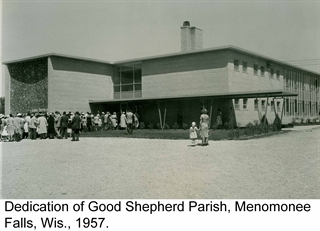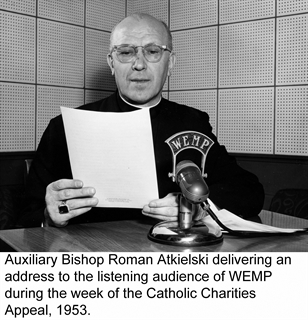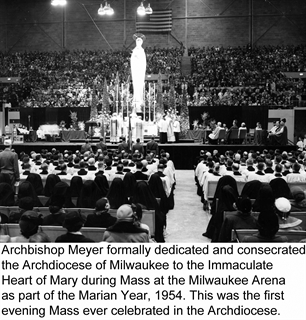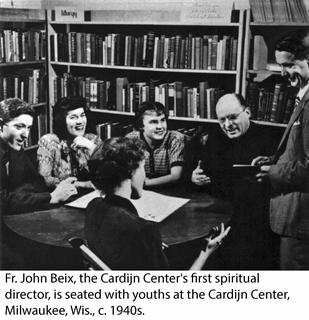A Bold New Age: 1945-1962
 Post-World War II America was full of challenges and significant advances for the Catholic community of southeastern Wisconsin. After a period of economic readjustment, the post-war economy hummed and thousands of people found opportunities for well-paying jobs, education, and solid family life. The baby boom took off after the war, peaking in 1957, with one baby being born every seven seconds. The Serviceman’s Readjustment Act (1944), otherwise known as the G.I. Bill of Rights, helped transition veterans back into civilian life by offering education. With good educations and better paying jobs, many Catholics now entered the middle class. Even industrial jobs, thanks to union wages, paid a fair living and benefits to many workers. Catholic colleges and universities boomed. Catholics also began to move in large numbers to the suburbs, transforming former pastures and farm land into neighborhoods in which new suburban churches with large parking lots and temporary buildings found their niche. In 1946, long pent-up growth in Wisconsin helped create the Diocese of Madison, with counties clipped from Milwaukee, La Crosse, and Green Bay.
Post-World War II America was full of challenges and significant advances for the Catholic community of southeastern Wisconsin. After a period of economic readjustment, the post-war economy hummed and thousands of people found opportunities for well-paying jobs, education, and solid family life. The baby boom took off after the war, peaking in 1957, with one baby being born every seven seconds. The Serviceman’s Readjustment Act (1944), otherwise known as the G.I. Bill of Rights, helped transition veterans back into civilian life by offering education. With good educations and better paying jobs, many Catholics now entered the middle class. Even industrial jobs, thanks to union wages, paid a fair living and benefits to many workers. Catholic colleges and universities boomed. Catholics also began to move in large numbers to the suburbs, transforming former pastures and farm land into neighborhoods in which new suburban churches with large parking lots and temporary buildings found their niche. In 1946, long pent-up growth in Wisconsin helped create the Diocese of Madison, with counties clipped from Milwaukee, La Crosse, and Green Bay.
 Archbishop Kiley tried to keep up with the changes, but the pace was fast and his conservative fiscal policies did not allow too much debt. Even with the help of a new auxiliary, Monsignor Roman Atkielski (1899-1969), expansion projects could not move forward at a necessary pace. Kiley’s health declined steadily until his death in April 1953.
Archbishop Kiley tried to keep up with the changes, but the pace was fast and his conservative fiscal policies did not allow too much debt. Even with the help of a new auxiliary, Monsignor Roman Atkielski (1899-1969), expansion projects could not move forward at a necessary pace. Kiley’s health declined steadily until his death in April 1953.
Albert Gregory Meyer (1903-1965), a native of Milwaukee and bishop of Superior, assumed the leadership of his hometown archdiocese in September 1953. Between 1953 and 1958, the Milwaukee archdiocese went on a building spree, adding millions of dollars in new churches, schools, additions to buildings, rectories, and convents. Catholic high schools came into their own, with new schools opening in Kenosha, and Whitefish Bay, and expansions to other schools in Milwaukee and Racine. Catholic colleges grew from the small seeds planted by the religious communities: Cardinal Stritch (OSF), Alverno (OSF-SSSF), Marian (CSA), Dominican (OP-Racine), and Mount Mary (SSND).
 Catholic devotional life flourished with the celebration of the Marian Year in 1954 and the activities of Catholic Youth in the archdiocesan organization Sodality Union of the Milwaukee Archdiocese (SUMA). The Archdiocese opened a Marian shrine to honor Our Lady of Fatima on Stevenson Avenue. This devotion was particularly encouraged as a way to combat the spread of international communism. Concern for youth was in evidence in the proliferation of Catholic high schools. Proper dress for young persons was stressed by Archbishop Meyer in his 1956 pastoral “Decency and Modesty.”
Catholic devotional life flourished with the celebration of the Marian Year in 1954 and the activities of Catholic Youth in the archdiocesan organization Sodality Union of the Milwaukee Archdiocese (SUMA). The Archdiocese opened a Marian shrine to honor Our Lady of Fatima on Stevenson Avenue. This devotion was particularly encouraged as a way to combat the spread of international communism. Concern for youth was in evidence in the proliferation of Catholic high schools. Proper dress for young persons was stressed by Archbishop Meyer in his 1956 pastoral “Decency and Modesty.”
Racial transition was underway in cities like Milwaukee, Racine, and Kenosha, as African Americans moved north to find jobs and escape from the horrors of southern apartheid, otherwise known as “Jim Crow” laws. The increase in the number and visibility of African Americans disturbed and challenged some whites, many of them Catholics, who sold their homes and moved away. Catholic parishes and schools in the path of this African American growth began to undergo transitions.
Major labor strike in Sheboygan and Kohler (the Kohler Strike of the 1950s) involved Catholics on both sides of the issue. Archbishop Meyer tried and failed make labor peace.
 Concern for social justice was active among Catholics in the specialized Catholic Action Movements (Young Christian Workers, Young Christian Students) and the Christian Family Movement. Father John Russell Beix helped create a center for these groups named after their founder Canon Joseph Cardijn of Belgium. The Cardijn Center opened in 1948 and was a book store, an adult education center, and a gathering place for these groups who dedicated themselves to social change through the axiom: “Observe. Judge. Act.” The Cardijn Center in many ways anticipated some of the changes that Vatican II would bring: participatory liturgy, social justice, and scripture study. These lessons inspired and formed a generation of Milwaukee Catholics.
Concern for social justice was active among Catholics in the specialized Catholic Action Movements (Young Christian Workers, Young Christian Students) and the Christian Family Movement. Father John Russell Beix helped create a center for these groups named after their founder Canon Joseph Cardijn of Belgium. The Cardijn Center opened in 1948 and was a book store, an adult education center, and a gathering place for these groups who dedicated themselves to social change through the axiom: “Observe. Judge. Act.” The Cardijn Center in many ways anticipated some of the changes that Vatican II would bring: participatory liturgy, social justice, and scripture study. These lessons inspired and formed a generation of Milwaukee Catholics.
Meyer succeeded Cardinal Samuel Stritch in Chicago in 1958 and in January 1959, William E. Cousins (1902-1988), former bishop of Peoria, came to Milwaukee. The very day that Cousins was installed in January 1959, Pope John XXIII announced his desire to convene an ecumenical council. Few American Catholics knew what that was. Even Archbishop Cousins was a bit confused. But three years later, Cousins took his place with over 2000 other bishops from around the world for this major event, which transformed the Catholic Church.
By: Rev. Steven M. Avella
Photographs and documents courtesy of the Archdiocese of Milwaukee Archives, unless otherwise noted. Photographs and documents cannot be reproduced without prior written authorization. For permission to reproduce contact the archdiocesan archives.